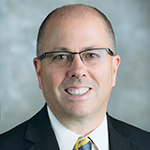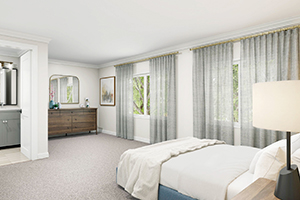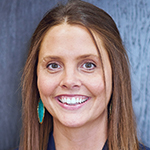By JULIE MINDA
Trinity Health Senior Communities is remodeling three of its senior living campuses in response to evolving preferences of seniors. The seniors' changing expectations were reflected in surveys the continuum of care system has conducted to inform the capital projects.

Kastner
Steven Kastner, president and chief executive of Trinity Health Senior Communities, says the organization learned in its surveys of current and prospective residents that "they want mind, body and spiritual wellness; they want dining options; they want bigger living spaces." Trinity Health is investing about $36.5 million total in the three campuses over the next several years to update interior spaces and to add independent living residences.
Kastner notes that the remodeling and construction projects are part of a larger effort at Trinity Health Senior Communities that started about five years ago to rebalance its portfolio of 23 communities in six Midwestern, Northeastern and Eastern states. The organization is downsizing the proportion of skilled nursing facilities on six of its campuses and increasing the proportion of independent living facilities.

Trinity Health Senior Communities is enlarging independent living apartments at some of its senior living facilities to meet the preferences of current and future residents. This rendering illustrates the bigger bedrooms being incorporated in apartment designs for St. Paul's Life Plan Community in South Bend, Indiana.
He says that it is important to prepare for the entrance into the market of baby boomers, who are now between the ages of 57 and 75. Boomers are not yet entering continuing care facilities in large numbers; they will begin doing so over the next decade.
"We continue to refine what we know and to learn more" about the coming generation of senior facility residents, he says. "We know the expectations of the baby boomer market are higher" than those of their parents, the generation that makes up the majority of residents on senior care campuses now.
Ahead of the curve
According to a 2014 analysis from the Milliman risk management, benefits and technology firm, people who enter continuing care retirement communities typically are ages 65 to 95. In the 20 years prior to the report's publication, average entry ages had increased from the mid-70s to the low 80s.
The report said a mature continuing care retirement community normally has an independent living population with an average age of between 85 and 87. Continuing care retirement communities are campuses that offer multiple levels of care and services that seniors access as their health and mobility dictates. Trinity Health Senior Communities calls these campuses "life plan communities."
Kastner says Trinity Health Senior Communities' work to update selected campuses is an effort to set its senior campuses up to offer the amenities boomers say they want. "As organizations, we (in the senior care market) are sometimes slow to react to change, and we end up with dated buildings that are not what people are looking for. We are trying to be proactive and stay competitive in the market, while also being good stewards."
Rebalancing
As to Trinity Health's decision to downsize or eliminate skilled nursing facilities on some campuses, he says the thinking behind this shift is that advances in telemedicine are enabling people to age in place at home or in independent living or assisted living facilities. Because of this and other factors, the expectation is that there will be slow growth in demand for skilled nursing facility care.
"People are going into our skilled nursing facilities more acutely ill than ever before," Kastner says. "There will always be a place for the skilled nursing facility in the future. However, we anticipate that these residents will continue to have increasing needs, more closely resembling patients in an acute care setting. We expect that baby boomers will be more likely to age in place in the home setting until their needs grow to the point that they need a much higher level of care. The skilled nursing facility will therefore be reserved for more acutely ill residents.
"The number of individuals coming to us with dementia will increase," he adds. "We believe that these residents are best cared for in the assisted living environment, where they are empowered to maintain their independence in a supportive environment for as long as possible," Kastner says. "Only in the end stage of their condition would they require skilled nursing care."
One package
Nora Wiley is a partner and executive vice president for Luminaut, the architecture firm planning the renovation work. She says in many communities, seniors have felt that they had a choice between for-profit facilities with all the bells and whistles but not enough attention to holistic wellness, and faith-based nonprofits that have the holistic focus but in outmoded facilities. "Trinity Health is now putting it all together in one package," she says.

Wiley
Generally, in the U.S., residents pay for independent and assisted living with private funds, including out-of-pocket and private insurance dollars. On the other hand, most skilled nursing care is paid by government insurers, primarily Medicaid. Kastner notes that while Trinity Health Senior Communities currently is focusing its revitalization on the areas of its campuses that attract more affluent seniors, it also is investing in upgrades that will benefit a broader array of residents.
Fitness, food and fun
The initial work is concentrated at three of its largest campuses: St. Paul's Life Plan Community in South Bend, Indiana; Glacier Hills Life Plan Community in Ann Arbor, Michigan; and Marycrest Life Plan Community in Livonia, Michigan.
The interior refresh of the St. Paul and Glacier Hill campuses is underway. The renovations include repurposing communal spaces for use as wellness, group fitness, game rooms and art studios and enlivening dining offerings with options including bistros and pubs. It will be beautifying and modernizing reception spaces and integrating technology throughout the campuses.
Kastner says a wired campus will allow for improved social networking and communications technology. Such technology proved to be "a game changer in terms of communications among physicians, our colleagues, residents and families" during the pandemic. "We have learned so much so quickly about how better to use technology," he says.
Plans call for the remodeling of existing independent living apartments or the construction of new ones on all three campuses. The new units will be larger than those available today. Some of these units will have two bedrooms, a living room and a den, to use as an office or hobby room or for entertaining. St. Paul's will add 25 such apartments, Glacier Hills, 30, and Marycrest, 45.
While the bulk of the work is centered around the independent living sections of the campuses, some will take place in the assisted living sections. Additionally, Trinity Health is in the process of converting semi-private skilled nursing rooms to private rooms in the facilities that are retaining skilled nursing.